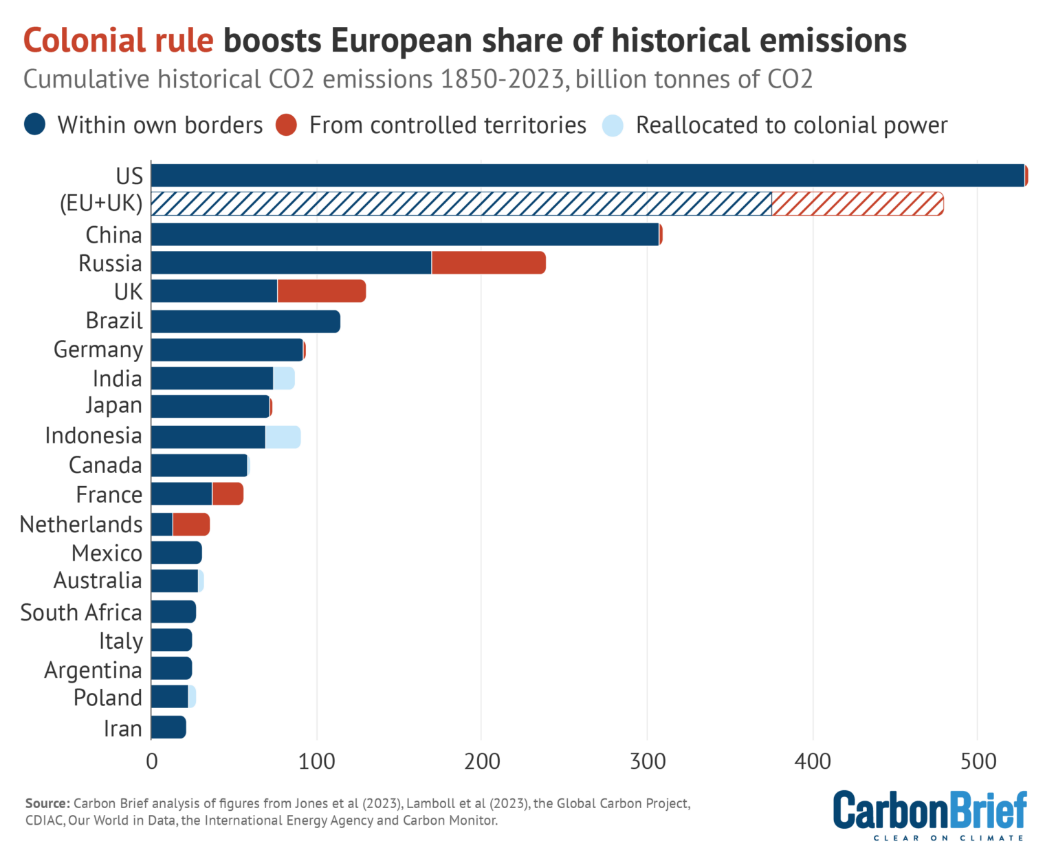Hey climate champions! Let’s talk numbers – and they’re big. Since the year 1850, humans have pumped a whopping 2,558 billion tonnes of CO2 into our atmosphere. And guess what? Our planet is feeling it, with global temperatures climbing by 1.15°C.
Hold onto your hats because here’s the kicker: as of 2021, we’ve already chewed through 86-89% of this carbon budget. And by the end of 2023, more than 92% of the budget for keeping things under a 1.5°C limit will be history. It’s a wake-up call, folks. The urgency to tackle climate change is hitting us square in the face.
But here’s the plot twist – not everyone’s playing fair. The responsibility for burning through this global carbon budget is way lopsided. Wealthy nations, especially those former colonial powers, are carrying a much heavier load. It’s time to unpack the concept of climate justice and shine a light on how emissions under colonial powers are flipping the script on the global warming narrative.
In this article, we’re diving into the questions of climate justice, exposing how the emissions from those former colonial big shots are rewriting the history of global warming. Get ready for a mind-shift as we challenge the norms of accountability, revealing a stark contrast in the historical contributions of former colonial powers and the territories they once dominated.
Stay tuned as we unravel the climate justice puzzle, one carbon footprint at a time.
Understanding Cumulative CO2
Before we dive into the nitty-gritty of this article, let’s dive into the world of cumulative CO2 emissions and why they matter in the grand scheme of our global climate.
Between the decades of 1850-2023, more than 90% of the CO2 we pumped into the atmosphere came from things like cutting down trees and other land-related activities. Fast forward to now, and the tables have turned – fossil fuels and cement are now the big players, contributing a whopping 91% of the CO2 we release into the air in 2023.
So, why should we care about all this cumulative CO2 stuff? Well, the answer lies in its serious impact on our planet during this ongoing climate crisis. The latest report from the Intergovernmental Panel on Climate Change (IPCC) spells it out – the warming of our Earth is a result of more than a century of us humans releasing greenhouse gases (GHGs) into the atmosphere. This includes emissions from things like how we use energy, changes in how we use land, the choices we make in our lifestyles, what we consume, and even how we produce stuff.
When it comes to CO2, the big culprits are the emissions from burning fossil fuels and messing with the way we use land. These emissions are like the Earth’s thermostat – the more CO2 we release, the hotter things get. It’s a straight-up cause-and-effect relationship, showing us that our actions are directly linked to the climate crisis getting worse.
Here’s the kicker: once we release CO2 into the air, it doesn’t just disappear. These molecules stick around for a long time, playing a sort of permanent role in cranking up global temperatures. Even though individual CO2 molecules don’t last forever, their impact lingers, shaping our planet’s climate for the long haul.
So, there you have it – a quick rundown on cumulative CO2 emissions and why they’re a big deal for our planet. It’s time to take action and make choices that steer us away from adding more fuel to the climate crisis fire.
The Concept of the Carbon Budget
Another important concept that needs to be explained is the Carbon Budget.
So, what exactly is this carbon budget thing? Think of it as the ultimate allowance for CO2 emissions that we can’t surpass if we want to keep global temperatures in check. It’s like a magic number we need to stay under to hit our climate goals.
Here’s where it gets real: our climate is in a bit of a pickle, and the carbon budget is like our lifeline. As of the end of 2023, we’re left with just 208 gigatons of CO2 before we hit the 1.5 degrees Celsius warming limit. To put it bluntly, that’s less than 8% of the budget left, and if we keep emitting like we are now, we’ll burn through the whole thing in less than five years. Yikes!
This isn’t a drill, folks. The urgency of the climate crisis hits home when you see how little room we have left in our carbon budget. It’s like our planet has a countdown clock, and time is running out fast. We need to make some serious changes, and we need to make them now.
Unravelling the Historical Threads: Who’s Really Responsible for Warming?
During the period of European imperialism, the UK was on the fast track to industrialization. Domestic deforestation, spurred by the coal craze and the need for timber imports, fueled an imperial expansion driven by steamships, railways, and motor vehicles. Meanwhile, colonial powers were busy setting up plantations and introducing new farming methods, causing deforestation and environmental changes across the Americas, the Caribbean, Asia, Africa, and Oceania.
The aftermath of this resource exploitation is still felt today, with lasting effects on landscapes and ecosystems. The legacy of colonial rule influences land use and environmental policies in many independent states. So, while the debate on the ongoing impact of colonial rule rages on, one thing’s for sure – historical emissions are still shaking things up in our fight against climate change.
Analyzing the Top Contributors
Let’s now hit the crux of the issue.
Picture this: back in the day, colonial powers were calling the shots, shaping landscapes, using up natural resources, and setting the stage for development patterns. But here’s the twist – their influence, often involving resource extraction from colonized lands, is now a key player in the warming drama we find ourselves in.Source: Carbon Brief
The chart above is an analysis of the top 20 countries based on cumulative historical CO2 emissions. It showed that major post-colonial European powers like the UK, France, and the Netherlands took center stage when it came to considering carbon emissions from a historical standpoint.
The chart further reveals that despite making up less than 11% of today’s global population, the United States, the European Union, and the United Kingdom together carry a whopping 39% of the blame for all the CO2 mess we’re dealing with.
Yep, you read that right!
Now, let’s shine a spotlight on the top dogs in historical CO2 emissions.
The UK sees a whopping 70% increase, France is up by 51%, and the Netherlands jumps a staggering 181%. Belgium (+33%), Portugal (+234%) and Spain (+12%) also get in on the action. Together, they’re cranking up the EU+UK’s responsibility for warming by almost a third, collectively boosting the EU+UK’s historical responsibility by a solid 28%.
Within that same historical framework, the United States takes the crown, belting out over 509 billion tonnes of CO2 and carrying a whopping 20% of the global burden. China follows; Russia is in the mix, and Brazil and Indonesia round out the top five, making waves with their land-related emissions.
But it’s not all doom and gloom. Former colonies like India (-15%) and Indonesia (-24%) catch a break, with a decreased share of cumulative emissions under this fresh perspective on historical responsibility. Russia, though, sees a surge in its historical responsibility for current warming, rising by two-fifths to 9.3% of the global total.
Do you see the implication, alright?
It means that these big economies not only should be cutting down on their own emissions, but they also need to step up and support climate efforts in less developed nations.
There you have it – a whirlwind tour of who’s really responsible for warming.
Implications for Climate Action
Alright, climate champs, here’s the scoop: the Carbon Brief analysis is turning the climate responsibility talk on its head, shining a big spotlight on the impact of colonial rule. As we face the urgent call for climate action, it’s high time we acknowledge that former colonial powers are carrying an unfair load.
This blog isn’t just a finger-pointing session but a wake-up call. Developed nations need to step up – not just in cutting their emissions but also in giving a helping hand to less developed countries. Why? Because we can’t ignore the lasting legacy of historical injustices.
In a nutshell, it’s time for a climate reality check. Let’s demand action, push for justice, and work together to build a planet-friendly future.
Found it interesting and would like more in the mail?




